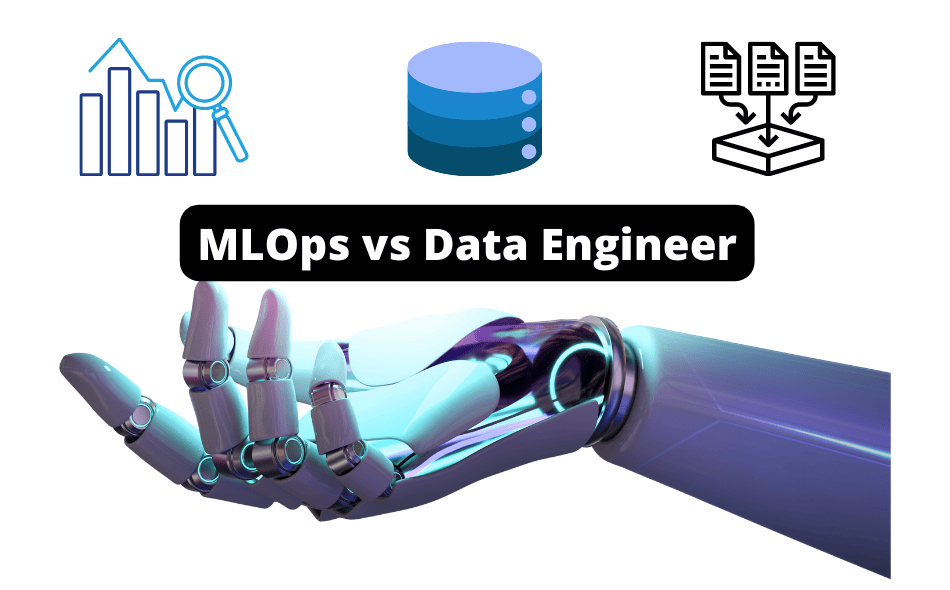In the fast-paced world of technology, two fields are currently blowing up.
These two roles: MLOps and Data Engineering, are crucial in transforming how businesses leverage data.
While one carves a path toward the seamless integration (seemingly impossible) and management of Machine Learning models, the other lays the robust foundation of Big Data architecture that fuels innovation.
But which one is the right path for you?
Is it the new and exciting world of MLOps, where models are built from experimental repos to production pipelines, constantly adapting to ever-changing regulations and customer needs?
Or is it Data Engineering, where data’s raw potential is harnessed into organized, accessible, and valuable?
This blog post will explore MLOps and Data Engineering, breaking down what they are and why they matter.
We’ll look at how much you might earn in these fields, what the jobs are like, and what makes them different.
This information will help you determine the best fit for your interests and career goals.
So, if you’re already working in technology or just curious about these exciting areas, come along with us. We’ll help you learn about two important jobs in our world of data and technology. By the end, you might know which matches you best!
** Note: I currently work in MLOPS so I may be slightly biased. **

What is Data Engineering?
Efficient Data Handling
Data Engineering plays a crucial role in ensuring efficient data handling within an organization. By implementing proper data structures, storage mechanisms, and organization strategies, data can be retrieved and manipulated with ease and speed. Here’s how it works:
- Organization: Sorting and categorizing data into meaningful groupings make it more navigable and searchable.
- Storage: Using optimal storage solutions that fit the specific data type ensures that it can be accessed quickly when needed.
- Integration: Combining data from various sources allows for a comprehensive view, which aids in more robust analysis and reporting.
Data Quality and Accuracy
Ensuring data quality and accuracy is paramount for making informed decisions:
- Cleaning: This involves identifying and correcting errors or inconsistencies in data to improve its quality. It can include removing duplicates, filling missing values, and correcting mislabeled data.
- Validation: Implementing rules to check the correctness and relevance of data ensures that only valid data is included in the analysis.
- Preprocessing: This may include normalization, transformation, and other methods that prepare the data for analysis, which ensures that the data is in the best possible form for deriving meaningful insights.
Scalability
Scalability in data engineering refers to the ability of a system to handle growth in data volume and complexity:
- Horizontal Scaling: Adding more machines to the existing pool allows handling more data without significantly changing the existing system architecture.
- Vertical Scaling: This involves adding more power (CPU, RAM) to an existing machine to handle more data.
- Flexible Architecture: Designing with scalability in mind ensures that the data handling capability can grow as the organization grows without a complete system overhaul.
Facilitating Data Analysis
Data Engineering sets the stage for insightful data analysis by:
- Data Transformation: This includes converting data into a suitable format or structure for analysis. It may involve aggregating data, calculating summaries, and applying mathematical transformations.
- Data Integration: Combining data from different sources provides a more holistic view, allowing analysts to make connections that might not be visible when looking at individual data sets.
- Providing Tools: By implementing and maintaining tools that simplify data access and manipulation, data engineers enable data scientists and analysts to focus more on analysis rather than data wrangling.
- Ensuring Timely Availability: Efficient pipelines ensure that fresh data is available for analysis as needed, enabling real-time or near-real-time insights.
Data Engineering forms the backbone and structure of most modern data-driven decision-making processes.
By focusing on efficient handling, quality, scalability, and facilitation of analysis, data engineers contribute to turning raw data into actionable intelligence that can guide an organization’s strategy and operations.

Famous Data Engineering Tools
Apache Hadoop
About: Apache Hadoop is an open-source framework that allows for the distributed processing of large data sets across clusters of computers.
Use: It uses simple programming models and is designed to scale from single servers to thousands of machines.
Apache Spark
About: Apache Spark is an open-source distributed computing system for fast computation.
Use: It provides an interface for entire programming clusters and is particularly known for its in-memory processing speed.
Kafka
About: Apache Kafka is an open-source stream-processing software platform.
Use: It’s used to build real-time data pipelines and streaming apps, often used for its fault tolerance and scalability.
Apache Flink
About: Apache Flink is an open-source stream-processing framework.
Use: It’s used for real-time computation that can perform analytics and complex event processing (CEP).
Snowflake
About: Snowflake is a cloud data platform that provides data warehouse features.
Use: It is known for its elasticity, enabling seamless computational power and storage scaling.
Airflow
About: Apache Airflow is an open-source tool to author, schedule, and monitor workflows programmatically.
Use: It manages complex ETL (Extract, Transform, Load) pipelines and orchestrates jobs in a distributed environment.
Tableau
About: Tableau is a data visualization tool that converts raw data into understandable formats.
Use: It allows users to connect, visualize, and share data in a way that makes sense for their organization.
Talend
About: Talend is a tool for data integration and data management.
Use: It allows users to connect, access, and manage data from various sources, providing a unified view.
Amazon Redshift
About: Amazon Redshift is a fully managed, petabyte-scale data warehouse service by Amazon.
Use: It allows fast query performance using columnar storage technology and parallelizing queries across multiple nodes.
Microsoft Azure HDInsight
About: Azure HDInsight is a cloud service from Microsoft that makes it easy to process massive amounts of big data.
Use: It analyzes data using popular open-source frameworks such as Hadoop, Spark, Hive, LLAP, Kafka, Storm, R, etc.
These tools collectively provide robust capabilities for handling, processing, and visualization of large-scale data and are integral parts of the data engineering landscape.
Docker (The KING of MLops):
About: Docker is a platform for developing, shipping, and running container applications.
Use in MLOps:
Containerization: Docker allows data scientists and engineers to package an application with all its dependencies and libraries into a “container.” This ensures that the application runs the same way, regardless of where the container is deployed, leading to consistency across development, testing, and production environments.
Scalability: In an MLOps context, Docker can be used to scale ML models easily. If a particular model becomes popular and needs to handle more requests, Docker containers can be replicated to handle the increased load.
Integration with Orchestration Tools: Docker can be used with orchestration tools like Kubernetes to manage the deployment and scaling of containerized ML models. This orchestration allows for automated deployment, scaling, and management of containerized applications.
Collaboration: Docker containers encapsulate all dependencies, ensuring that all team members, including data scientists, developers, and operations, work in the same environment. This promotes collaboration and reduces the “it works on my machine” problem.
Version Control: Containers can be versioned, enabling easy rollback to previous versions and ensuring that the correct version of a model is deployed in production.
Docker has become an essential part of the MLOps toolkit because it allows for a seamless transition from development to production, enhances collaboration, and supports scalable and consistent deployment of machine learning models.






